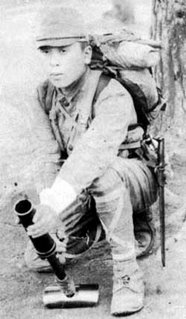
Born out of the need to bridge the gap in range between hand grenades and mortars, the grenade discharger evolved in the Imperial Japanese Army from a special purpose weapon of infantry assault and defense to an essential item of standard equipment with all Japanese ground forces.
Commonly called Juteki by the Japanese, this weapon officially was designated Hachikyu Shiki Jutekidarto, or 1189 Model Heavy Grenade Discharger, the term "heavy" being justified by the powerful 1-pound, 12-ounce high explosive shell it was designed to fire, although it also fired the standard Model 91 fragmentation grenade.
To the American Marines and soldiers who first encountered this weapon and others of its kind in combat they were known as "knee mortars," likely so named because they generally were fired from a kneeling position. Typically, the discharger's concave baseplate was pressed firmly into the surface of the ground by the firer's foot to support the heavy recoil of the fired shell, but unfortunately the term "knee mortar" suggested to some untutored captors of these weapons that they were to be fired with the baseplate resting against the knee or thigh. When a Marine fired on of these dischargers from his thigh and broke his upper leg bone, efforts were swiftly undertaken in the field to educate all combat troops in the safe and proper handling of these very useful weapons.
The Model 89 (1929) 50mm Heavy Grenade Discharger is a muzzle-loaded, high-angle-of-fire weapon which weighs 10-1/4 pounds and is 24 inches in overall length. Its design is compact and simple. The discharger has three major components: the rifled barrel, the supporting barrel pedestal with firing mechanism, and the base plate. Operation of the Model 899 was easy and straightforward, and with practice its user could deliver accurate fire registered quickly on target.
Encountered in all major battles in the Pacific War, the Model 89 Grenade Discharger was an uncomplicated, very portable, and highly efficient weapon operated easily by one man. It was carried in a cloth or leather case with a sling, and its one-piece construction allowed it to be brought into action very quickly. This grenade discharger had the advantage over most mortars in that it could be aimed and fired mechanically after a projectile had been placed in the barrel, projectile firing not being dependent upon dropping down the barrel against a stationary firing pin as with most mortars, where barrel fouling sometimes caused dangerous hangfires. Although an instantaneous fuze employed on the Model 89 high explosive shell restricted this shell's use to open areas, the Model 91 fragmentation grenade with its seven-second fuze made this discharger effective in a jungle or forest setting, with complete safety for the user from premature detonation of projectiles by overhanging foliage. Smoke and signal shells, and an incendiary grenade, were special types of ammunition used with this versatile and effective weapons which won the respect of all who came to know it.—Edwin F. Libby
No comments:
Post a Comment